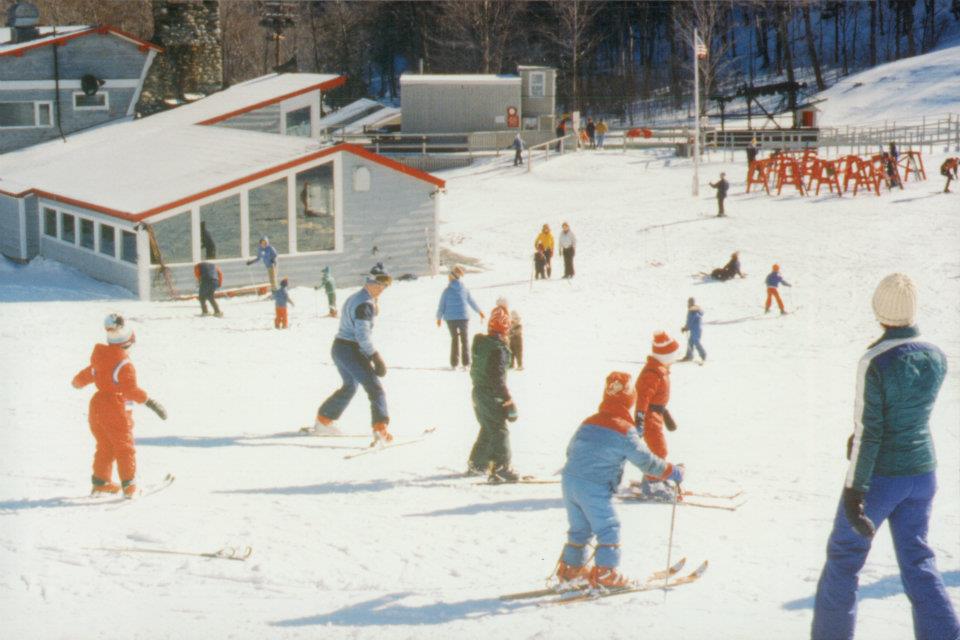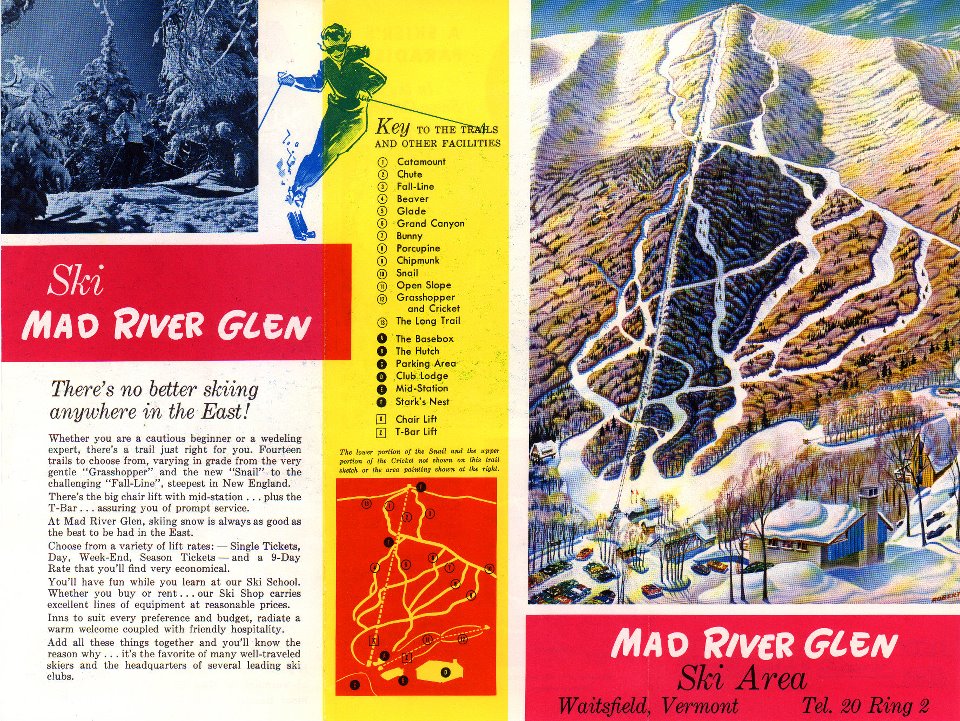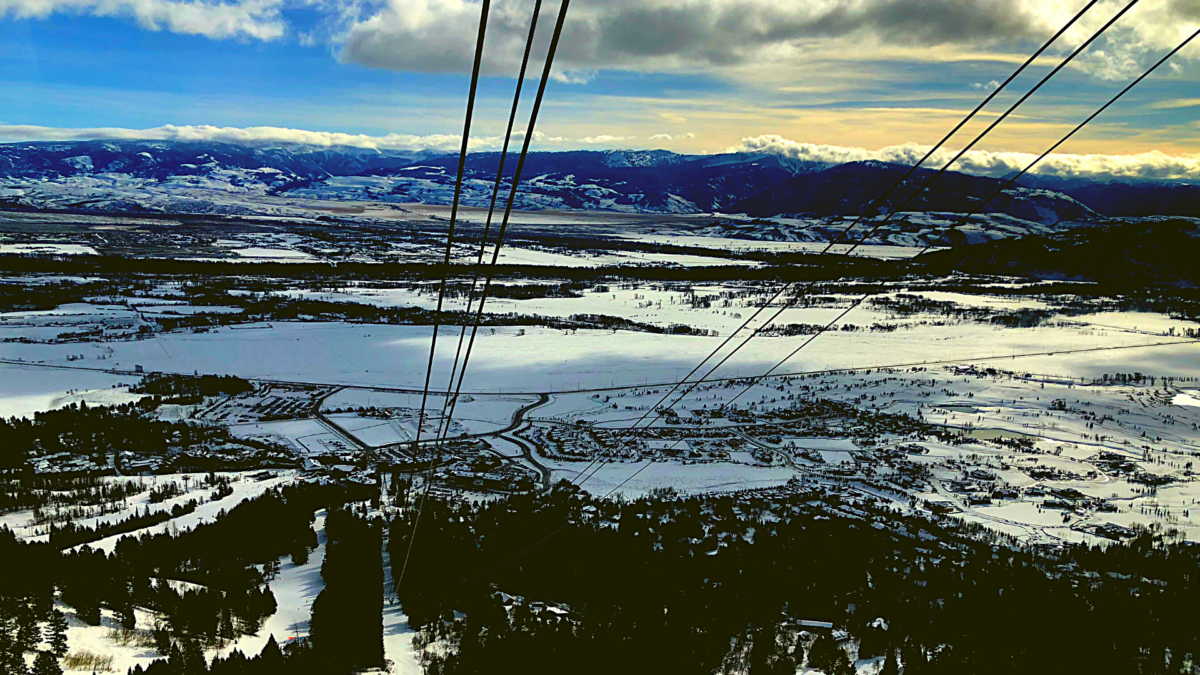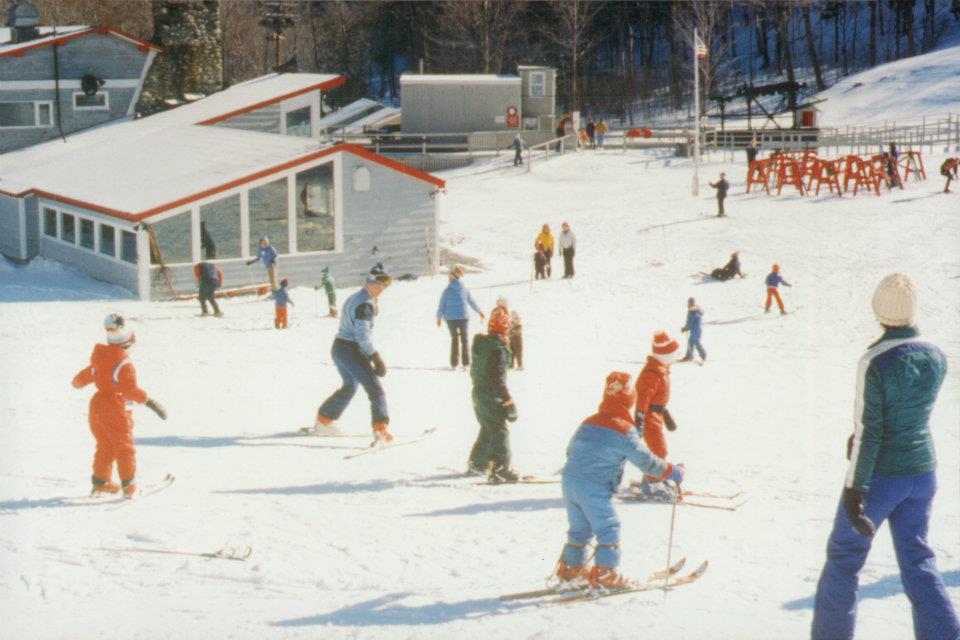In this day and age, skiing is a heavily commercialized and largely corporate-owned endeavor with a relatively niche community that participates in skiing. There is a uniform aspect to large resorts, such as Vail and Alterra, but one resort stands alone: Mad River Glen. With an incredibly rich history, Mad River Glen is the only successful cooperative ski resort to exist in the United States. The thriving community surrounding Mad River Glen in the wake of monster corporations acquiring smaller resorts makes them a unique resort.
From the very beginning, Mad River Glen sought to be different as a ski resort. In 1948, their founder Roland Palmedo, wanted to develop a skiing experience for sport as opposed to profit. Famously put by Palmedo:
A ski area is not just a place of business, a mountain amusement park…instead it is a winter community whose members, both skiers and area personnel, are dedicated to the enjoyment of the sport.

Image Credit: https://www.facebook.com/SkiItIfYouCan/photos/a.10151261053245432/10151261056065432 Reproduced with Permission from Mad River Glen.
What Makes Mad River Glen Different
This sentiment rings true today as Mad River Glen and its executive director, Eric Friedman, take pride in having the hardest ski terrain and the ability to attract the best skiers in the country to the mountain. For the athletes visiting Mad River Glen, their sole purpose is to ski. External issues, such as functional bathrooms or high quality food, do not matter as long as the single chair lift can bring them up the mountain on a good powder day.
Mad River Glen is not built for the average skier. Some individuals are inherently turned away by the ban on snowboarding, the single chair lift and how difficult the slopes are due to a lack of artificial snowmaking. As Palmedo mentioned, this mountain is not intended to be an amusement park. The charades one may encounter at commercial resorts under the guise of big names that cater to a tourist’s every desire including expensive food, gifts and merchandise are a superfluous endeavor to Mad River Glen. This is not to say that Mad River Glen has not created its own brand. In fact, one can find bumper stickers all over the country reading, “Mad River Glen, ski it if you can,” signifying the skill required to maneuver down the windy trails.
The Beginnings of Mad River Glen
There are quite a few distinctive qualities to Mad River Glen, as it was not always a co-op resort. Like many ski resorts in the Northeast, Mad River Glen’s origins come after World War II. Palmedo returned from abroad after serving in both World War I and World War II as a Navy pilot. He was eager to find the perfect plot of land for his vision. He scouted a couple of neighboring mountains including Killington Peak, Mount Ellen, and Mount Abraham, but found that terrain on General Stark Mountain was far superior. After a couple years of work, and, notably, collaborating with the American Steel and Wire Company to create the fastest Single Chair lift in the world at the time, the mountain opened up on December 11, 1948 for the 1949 ski season. Mad River Glen thrived and stayed relatively the same while other resorts pursued snowmaking and groomed their runs throughout the coming years.
In 1972, Truxton Pratt, his wife Betsy, and real estate developer Brad Swett bought out Mad River Glen. They initially had a bigger vision for what Mad River Glen could become as Swett poised the idea of adding a base village, additional lifts, and condominiums. Three years after Pratt’s sudden death, his wife Betsy decided to buy out Swett. For the next 20 years, she remained in charge of Mad River Glen. Pratt publicly stated that she hated the ski industry and wanted to carry out the vision Palmedo held for the mountain. Pratt reigned with a tight fist and corn cob pipe in her mouth, as she is known for banning snowboarders from the mountain, hesitantly allowing snowmaking, and running Mad River Glen on a tight budget. Eventually she wanted to sell the resort, but only to someone to whom she could entrust the mountain in order to carry out Palemedo’s vision. She found that for the sake of continuing to preserve the mountain and its distinctive qualities, it made the most sense to sell the resort to the skiers themselves. That is exactly what happened on December 5, 1995. On that day, the Mad River Glen Cooperative was formed. It ushered in a new era of skiing. During this period, the ski industry was transforming into a more homogenized experience. Mad River Glen sought the exact opposite.
Betsy Pratt, as well as the shareholders of Mad River Glen, understand that their resort is a special place that does not attract the ordinary skier, nor does it attract the seemingly logical conclusions for the future of the mountain. For instance, the partnership of the Preservation Trust of Vermont and the Stark Mountain Foundation in 2007 allowed Mad River Glen to successfully raise 1.8 million dollars purely through donations. They used this money to renovate the single chair ski lift, rather than implementing a more practical double chairlift, which would have cost 400,000 dollars less. Roughly 80% of the shareholders voted to restore what is praised to be an iconic chair ski lift, which showcases the importance of upholding the integrity of the mountain and the history behind it.
The same was true when the co-op revisited the issue of the ban on snowboarding. Originally, snowboarding was allowed from 1986 through1992, but was banned specifically on the single chair lift. Snowboarders would swing the chairs as they dismounted onto the slopes, which resulted in Betsy Pratt hiring an individual to catch them. When confronted by a couple of snowboarders armed with a camera in the grocery store, Pratt held her ground and stated on camera that Mad River Glen was a “ski area anyway so forget snowboarding.” From there, snowboarding was banned from the entire mountain, as opposed to just the single chair lift. This belief still resonated with the co-op board members. When the issue of snowboarding was revisited in 1996, 76% of the members voted to uphold the ban. In order for the ban to be overturned, a two-thirds majority is needed, which signifies that the ban will not likely be lifted anytime soon. Mad River Glen is one of only three resorts in the country that still holds a snowboarding ban, along with Alta and Deer Valley, both located in Utah. The majority of skiers at Mad River Glen enjoy the fact that snowboarding is banned, as it can lead to unnecessary and dangerous collisions. Due to the nature of Stark Mountain’s twisty and turny slopes, as well as the absence of grooming and snowmaking, it is more difficult for snowboarders to maneuver down the mountain. Snowboarding down mountains can also scrape the snow in a way that is difficult for skiers, leading to a frustrating run.

Image Credit: https://www.facebook.com/SkiItIfYouCan/photos/a.10150286493560432/10150286495235432 Reproduced with Permission from Mad River Glen.
National Register of Historic Places
One of the primary points of pride for Mad River Glen is its status as the only ski area in the county recognized as a historic district in the National Register of Historic Places. The most gratifying aspect of the nomination and eventual approval on July 5, 2012, is the National Register’s choice to recognize the entire mountain, as opposed to solely the famous single chair lift. From this honor stems the creation of the hand-cut trails that highlight the natural features of the summit. Palmedo in the 1940s chose this approach, as opposed to utilizing destructive machines, including bulldozers and dynamite, which artificially manufacture ski trails, rather than craft them to the contours of the mountain. The are distinguished by their natural features, like the untouched rock ledges that have been preserved over the years. From Mad River Glen’s creation up to the present day, this nomination showcases the dedication and deep respect with which the community members hold the co-op’s mission:
To forever protect the classic Mad River Glen skiing experience by preserving low skier density, natural terrain and forests, varied trail character and friendly community atmosphere for the benefit of shareholders, area personnel and patrons.
The upkeep of the mountain, as opposed to the maintenance of the resort itself, is the ultimate goal of Mad River Glen, in order to preserve a ski area for present and future generations.
The people that make up Mad River Glen are the ones who provide such an exhilarating, “write-home-to-mom” experience that brings back workers and skiers alike year after year. As former executive director Eric Friedman states in our 2022 interview, “when you park your car there’s a sense of place that’s palpable.” Mad River Glen has always been community-oriented and never relied on providing international work visas as a means to attract employees from places outside the country to staff the resort. It is rumored that the workers of Sugarbush and neighboring mountains send their children over to Mad River Glen Ski school because they are aware of the accomplished ski instructors and trails that exist across the pond. A famous “Betsy-ism” that Friedman mentions is that, “if you keep grooming everything it’s a tennis court,” in response to the idea of Mad River Glen adopting the common practice of over grooming its ski trails. In other words, skiing becomes a homogenous experience when patrons visit big ticket resorts. Their first priority is profit as opposed to the sport of skiing itself and upholding the integrity of the mountain. Instead, big resorts provide an experience that is more palpable to a tourist and family friendly market to maximize profits. That is the very antithesis of Mad River Glen.
Conclusion
So how has Mad River Glen over the years weathered the conditions of Covid-19 and current trends in the ski industry such as Epic and Ikon passes? Since the pandemic, the resort has seen the largest increase in share purchases to date as people are eager to ski after being cooped up in the house for months. What is distinctive about Mad River Glen is that shareholders are always able to access the mountain despite any Covid-19 restrictions. Mad River Glen currently has 2,300 shareholders. In the spirit of the co-op no one can own more than four shares at a time. Regardless of the number of shares someone owns, all shareholders have only one vote per person. The resort has also opted out in participating in any partnerships with other ski areas rather than create season passes where skiers can hop from one resort to another at a discounted rate. Mad River Glen is reported to have had opportunities with neighboring resorts, but has not found a match with which it feels comfortable. The resounding feedback from the skiers and shareholders alike is that they enjoy the mountain’s independent spirit. That is the embodiment of the Mad River Glen way.
I would just like to acknowledge Ry Young at Mad River Glen for providing permission to use the photos above. Thank you again for allowing me to use these historic pieces in my project. I would also like to thank Eric Friedman for allowing such an exuberant interview for one of the coolest mountains to exist on the East Coast. Thank you for allowing me to be a scholar in all things Mad River Glen.
Bibliography
Albers, Jan. Hands on the Land: A History of the Vermont Landscape. Cambridge: MIT, 2002.
Buchanan, Eugene. “Mad River Glen Co-Op Celebrates 25th Anniversary and Unique Business Model” SGB Media Online , SGB Media, 12 Jan. 2021, https://sgbonline.com/mad-river-glen-co-op-celebrates-25th-anniversary-and-unique-business-model/.
Denning, Andrew Skiing into Modernity: A Cultural and Environmental History. Oakland, CA: University of California Press, 2015.
Friedman, Eric. “Mad River Glen and Its Single Chair.” The Burlington Free Press, Burlington, 6 Feb. 2015, https://www.burlingtonfreepress.com/story/news/local/2015/02/05/history-space-mad-river-glen/22930535/.
Harrison, Blake. “Tracks across Vermont: Vermont Life and the Landscape of Downhill Skiing, 1946-1970.” Journal of Sport History, vol. 28, no. 2, 2001, pp. 253–70
Kerr, Mary K. A Mountain Love Affair: The Story of Mad River Glen. Waitsfield: Mad River Glen, 2008.
Lund, Mort, et al. “Timeline of Important Ski History Dates.” Timeline of Important Ski History Dates | International Skiing History Association, https://skiinghistory.org/history/timeline-important-ski-history-dates.
Lynn, Lisa, et al. “Long Live the Rebel Ski Area.” VT SKI + RIDE, 21 Feb. 2019, https://vtskiandride.com/soul-revival-70-years-of-mad-river-glen/.
MacArthur, Paul J. “The Mountain Without A Snowboard.” Vermont Magazine, Feb. 2005, http://wrestlingperspective.com/mrg.html.
“Mad River Glen: Vermont: Skiing: Ski It If You Can!” Mad River Glen, Vermont, 12 Apr. 2022, https://madriverglen.com/.
Mohr, Brian. “Good Ol’ Mad River Glen.” ESPN, ESPN Internet Ventures, 28 Nov. 2012, https://www.espn.com/espnw/news-commentary/story/_/id/8687845/vermont-mad-river-glen-added-national-register-historic-places.
Traub, James, et al. “Mad River Glen.” Outside Online, 26 June 2021, https://www.outsideonline.com/outdoor-adventure/snow-sports/resort-time-forgot/.
Values and Sport: The Development of New England Skiing, 1870-1940.” The Oral History Review, vol. 13, 1985, pp. 55–76,
Walser, Lauren. “Mad River Glen’s Single-Chair Lift: Restoring an Icon: National Trust for Historic Preservation.” Mad River Glen’s Single-Chair Lift: Restoring an Icon | National Trust for Historic Preservation, 30 Dec. 2014, https://savingplaces.org/stories/mad-river-glens-single-chair-lift-restoring-icon#.Ym1IjtPMLOQ.


Nice post.
You helped me a lot with this post. I love the subject and I hope you continue to write excellent articles like this.